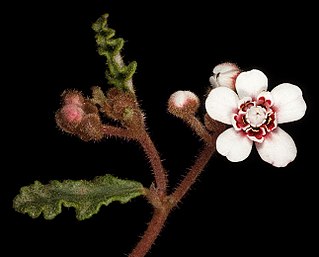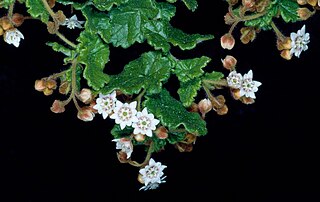Rulingia is a genus of flowering plants native to Australia and Madagascar. In 2011, all species were transferred to Commersonia with the exception of Rulingia cuneata, R. loxophylla, R. luteiflora and R. procumbens which have been transferred to the new genus Androcalva.
Achnophora is a genus of flowering plants in the family Asteraceae described as a genus in 1883.

Androcalva fraseri, commonly known as blackfellow's hemp or brush kurrajong, is a species of flowering plant in the family Malvaceae and is endemic to eastern Australia. It is a small tree or shrub that forms suckers and has egg-shaped or lance-shaped leaves with serrated edges, and clusters of 13 to 21 white flowers.

Androcalva is a genus of 33 species of flowering plants in the family Malvaceae and is endemic to continental Australia.
Haegiela is a genus of flowering plants in the family Asteraceae described as a genus in 1990. There is only one known species, Haegiela tatei, native to South Australia, and Victoria.

Androcalva rosea, commonly known as Sandy Hollow commersonia, is a small endangered shrub with pink flowers and prostrate trailing branches. It is only known from four locations in the Hunter Valley of New South Wales.

Androcalva luteiflora is a species of flowering plant in the family Malvaceae and is endemic to western Australia. It is an erect, sucker-forming shrub with egg-shaped leaves, the edges irregularly toothed, and clusters of 3 to 18 or more yellow flowers.

Androcalva pulchella is a shrub in the family Malvaceae. It is native to Western Australia.
Androcalva cuneata is a species of flowering plant in the family Malvaceae and is endemic to the south-west of Western Australia. It is a low, spreading, densely hairy shrub that sometimes forms suckers and has wedge-shaped leaves and clusters of 5 to 15 pink flowers.

Androcalva loxophylla is a species of flowering plant in the family Malvaceae and is endemic to northern Australia. It is a shrub with spreading or low-lying branches, oblong to broadly elliptic leaves and clusters of 4 to 20 yellow flowers.
Androcalva adenothalia is a species of flowering plant in the family Malvaceae and is endemic to the south-west of Western Australia. It is a prostrate shrub with hairy stems, broadly egg-shaped leaves with rounded teeth on the edges, and clusters of 4 to 9 or more white flowers.
Androcalva aphrix is a species of flowering plant in the family Malvaceae and is endemic to the south-west of Western Australia. It is a dwarf, prostrate, hairy shrub with clusters of 14 or more pink or white flowers.
Androcalva argentea is a species of flowering plant in the family Malvaceae and is endemic to Queensland. It is a tall shrub that forms suckers from rhizomes and has silvery branchlets and leaves, the leaves egg-shaped with wavy edges and serrated, and dense clusters of 10 to 30 white to cream-coloured flowers.
Androcalva bivillosa is a species of flowering plant in the family Malvaceae and is endemic to the south-west of Western Australia. It is a prostrate, spreading shrub with clusters of 3 to 9 white to pink flowers.

Androcalva crispa, commonly known as crisped leaf commersonia, is a species of flowering plant in the family Malvaceae and is endemic to the south-west of Western Australia. It is a prostrate shrub that forms suckers from rhizomes and has densely new growth, clusters of lobed, egg-shaped or oblong leaves with wavy, serrated edges, and groups of white and pinkish-purple flowers.

Androcalva gaudichaudii is a species of flowering plant in the family Malvaceae and is endemic to the far west of Western Australia. It is a low, dense shrub that forms suckers and has broadly oval leaves with a heart-shaped base, and clusters of 2 to 11 white flowers.
Androcalva incilis is a species of flowering plant in the family Malvaceae and is endemic to the south-west of Western Australia. It is a prostrate shrub with dark green, narrowly wedge-shaped to narrowly oblong leaves, and crowded heads of 8 to 12 deep pink flowers.
Androcalva lachna is a species of flowering plant in the family Malvaceae and is endemic to the far west of Western Australia. It is an erect shrub with egg-shaped leaves, and heads of 4 to 12 white and pink flowers.

Androcalva melanopetala is a species of flowering plant in the family Malvaceae and is endemic to southern inland Western Australia. It is a sometimes prostrate shrub that has densely hairy new growth, egg-shaped to elliptic leaves with rounded teeth on the edges, and clusters of white or cream-coloured and pink to red flowers.
Androcalva pearnii is a species of flowering plant in the family Malvaceae and is endemic to the Blackdown Tableland National Park in eastern Queensland. It is shrub that forms suckers and has hairy new growth, wavy, oblong to elliptic leaves with rounded lobes on the edges, and groups of 3 to 8 white and cream-coloured to pale green flowers.








